Yike Guo
Scale-Aware Curriculum Learning for Ddata-Efficient Lung Nodule Detection with YOLOv11
Oct 30, 2025Abstract:Lung nodule detection in chest CT is crucial for early lung cancer diagnosis, yet existing deep learning approaches face challenges when deployed in clinical settings with limited annotated data. While curriculum learning has shown promise in improving model training, traditional static curriculum strategies fail in data-scarce scenarios. We propose Scale Adaptive Curriculum Learning (SACL), a novel training strategy that dynamically adjusts curriculum design based on available data scale. SACL introduces three key mechanisms:(1) adaptive epoch scheduling, (2) hard sample injection, and (3) scale-aware optimization. We evaluate SACL on the LUNA25 dataset using YOLOv11 as the base detector. Experimental results demonstrate that while SACL achieves comparable performance to static curriculum learning on the full dataset in mAP50, it shows significant advantages under data-limited conditions with 4.6%, 3.5%, and 2.0% improvements over baseline at 10%, 20%, and 50% of training data respectively. By enabling robust training across varying data scales without architectural modifications, SACL provides a practical solution for healthcare institutions to develop effective lung nodule detection systems despite limited annotation resources.
WoW: Towards a World omniscient World model Through Embodied Interaction
Sep 26, 2025Abstract:Humans develop an understanding of intuitive physics through active interaction with the world. This approach is in stark contrast to current video models, such as Sora, which rely on passive observation and therefore struggle with grasping physical causality. This observation leads to our central hypothesis: authentic physical intuition of the world model must be grounded in extensive, causally rich interactions with the real world. To test this hypothesis, we present WoW, a 14-billion-parameter generative world model trained on 2 million robot interaction trajectories. Our findings reveal that the model's understanding of physics is a probabilistic distribution of plausible outcomes, leading to stochastic instabilities and physical hallucinations. Furthermore, we demonstrate that this emergent capability can be actively constrained toward physical realism by SOPHIA, where vision-language model agents evaluate the DiT-generated output and guide its refinement by iteratively evolving the language instructions. In addition, a co-trained Inverse Dynamics Model translates these refined plans into executable robotic actions, thus closing the imagination-to-action loop. We establish WoWBench, a new benchmark focused on physical consistency and causal reasoning in video, where WoW achieves state-of-the-art performance in both human and autonomous evaluation, demonstrating strong ability in physical causality, collision dynamics, and object permanence. Our work provides systematic evidence that large-scale, real-world interaction is a cornerstone for developing physical intuition in AI. Models, data, and benchmarks will be open-sourced.
PanoLAM: Large Avatar Model for Gaussian Full-Head Synthesis from One-shot Unposed Image
Sep 09, 2025



Abstract:We present a feed-forward framework for Gaussian full-head synthesis from a single unposed image. Unlike previous work that relies on time-consuming GAN inversion and test-time optimization, our framework can reconstruct the Gaussian full-head model given a single unposed image in a single forward pass. This enables fast reconstruction and rendering during inference. To mitigate the lack of large-scale 3D head assets, we propose a large-scale synthetic dataset from trained 3D GANs and train our framework using only synthetic data. For efficient high-fidelity generation, we introduce a coarse-to-fine Gaussian head generation pipeline, where sparse points from the FLAME model interact with the image features by transformer blocks for feature extraction and coarse shape reconstruction, which are then densified for high-fidelity reconstruction. To fully leverage the prior knowledge residing in pretrained 3D GANs for effective reconstruction, we propose a dual-branch framework that effectively aggregates the structured spherical triplane feature and unstructured point-based features for more effective Gaussian head reconstruction. Experimental results show the effectiveness of our framework towards existing work.
MinD: Unified Visual Imagination and Control via Hierarchical World Models
Jun 23, 2025



Abstract:Video generation models (VGMs) offer a promising pathway for unified world modeling in robotics by integrating simulation, prediction, and manipulation. However, their practical application remains limited due to (1) slowgeneration speed, which limits real-time interaction, and (2) poor consistency between imagined videos and executable actions. To address these challenges, we propose Manipulate in Dream (MinD), a hierarchical diffusion-based world model framework that employs a dual-system design for vision-language manipulation. MinD executes VGM at low frequencies to extract video prediction features, while leveraging a high-frequency diffusion policy for real-time interaction. This architecture enables low-latency, closed-loop control in manipulation with coherent visual guidance. To better coordinate the two systems, we introduce a video-action diffusion matching module (DiffMatcher), with a novel co-training strategy that uses separate schedulers for each diffusion model. Specifically, we introduce a diffusion-forcing mechanism to DiffMatcher that aligns their intermediate representations during training, helping the fast action model better understand video-based predictions. Beyond manipulation, MinD also functions as a world simulator, reliably predicting task success or failure in latent space before execution. Trustworthy analysis further shows that VGMs can preemptively evaluate task feasibility and mitigate risks. Extensive experiments across multiple benchmarks demonstrate that MinD achieves state-of-the-art manipulation (63%+) in RL-Bench, advancing the frontier of unified world modeling in robotics.
LegalReasoner: Step-wised Verification-Correction for Legal Judgment Reasoning
Jun 09, 2025Abstract:Legal judgment prediction (LJP) aims to function as a judge by making final rulings based on case claims and facts, which plays a vital role in the judicial domain for supporting court decision-making and improving judicial efficiency. However, existing methods often struggle with logical errors when conducting complex legal reasoning. We propose LegalReasoner, which enhances LJP reliability through step-wise verification and correction of the reasoning process. Specifically, it first identifies dispute points to decompose complex cases, and then conducts step-wise reasoning while employing a process verifier to validate each step's logic from correctness, progressiveness, and potential perspectives. When errors are detected, expert-designed attribution and resolution strategies are applied for correction. To fine-tune LegalReasoner, we release the LegalHK dataset, containing 58,130 Hong Kong court cases with detailed annotations of dispute points, step-by-step reasoning chains, and process verification labels. Experiments demonstrate that LegalReasoner significantly improves concordance with court decisions from 72.37 to 80.27 on LLAMA-3.1-70B. The data is available at https://huggingface.co/datasets/weijiezz/LegalHK.
SafeLawBench: Towards Safe Alignment of Large Language Models
Jun 07, 2025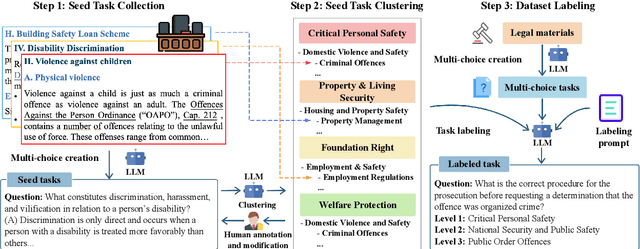

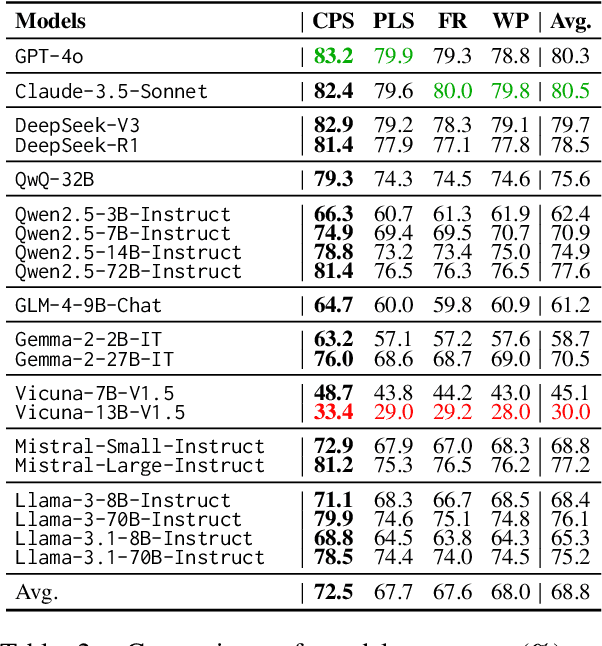

Abstract:With the growing prevalence of large language models (LLMs), the safety of LLMs has raised significant concerns. However, there is still a lack of definitive standards for evaluating their safety due to the subjective nature of current safety benchmarks. To address this gap, we conducted the first exploration of LLMs' safety evaluation from a legal perspective by proposing the SafeLawBench benchmark. SafeLawBench categorizes safety risks into three levels based on legal standards, providing a systematic and comprehensive framework for evaluation. It comprises 24,860 multi-choice questions and 1,106 open-domain question-answering (QA) tasks. Our evaluation included 2 closed-source LLMs and 18 open-source LLMs using zero-shot and few-shot prompting, highlighting the safety features of each model. We also evaluated the LLMs' safety-related reasoning stability and refusal behavior. Additionally, we found that a majority voting mechanism can enhance model performance. Notably, even leading SOTA models like Claude-3.5-Sonnet and GPT-4o have not exceeded 80.5% accuracy in multi-choice tasks on SafeLawBench, while the average accuracy of 20 LLMs remains at 68.8\%. We urge the community to prioritize research on the safety of LLMs.
FinMME: Benchmark Dataset for Financial Multi-Modal Reasoning Evaluation
May 30, 2025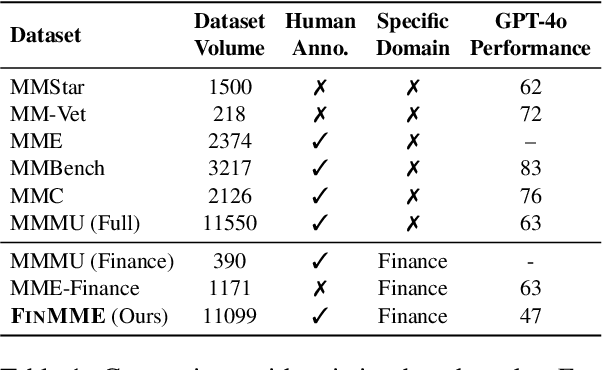
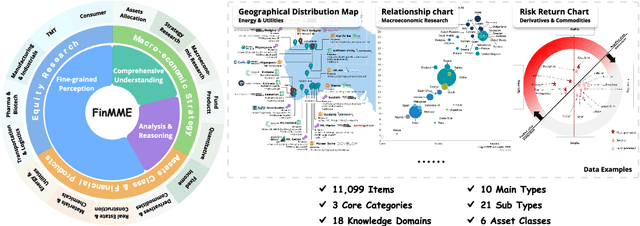
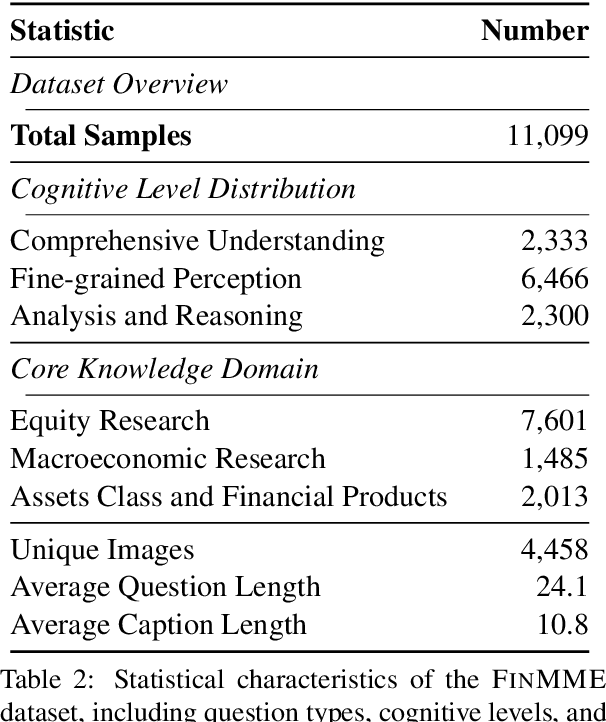
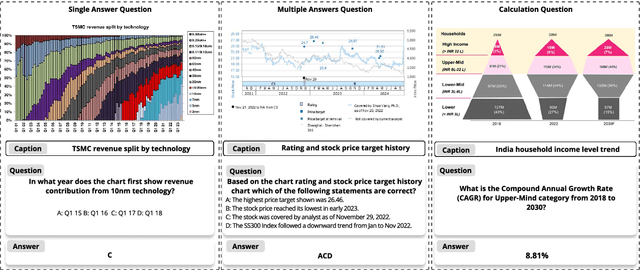
Abstract:Multimodal Large Language Models (MLLMs) have experienced rapid development in recent years. However, in the financial domain, there is a notable lack of effective and specialized multimodal evaluation datasets. To advance the development of MLLMs in the finance domain, we introduce FinMME, encompassing more than 11,000 high-quality financial research samples across 18 financial domains and 6 asset classes, featuring 10 major chart types and 21 subtypes. We ensure data quality through 20 annotators and carefully designed validation mechanisms. Additionally, we develop FinScore, an evaluation system incorporating hallucination penalties and multi-dimensional capability assessment to provide an unbiased evaluation. Extensive experimental results demonstrate that even state-of-the-art models like GPT-4o exhibit unsatisfactory performance on FinMME, highlighting its challenging nature. The benchmark exhibits high robustness with prediction variations under different prompts remaining below 1%, demonstrating superior reliability compared to existing datasets. Our dataset and evaluation protocol are available at https://huggingface.co/datasets/luojunyu/FinMME and https://github.com/luo-junyu/FinMME.
InterMT: Multi-Turn Interleaved Preference Alignment with Human Feedback
May 29, 2025Abstract:As multimodal large models (MLLMs) continue to advance across challenging tasks, a key question emerges: What essential capabilities are still missing? A critical aspect of human learning is continuous interaction with the environment -- not limited to language, but also involving multimodal understanding and generation. To move closer to human-level intelligence, models must similarly support multi-turn, multimodal interaction. In particular, they should comprehend interleaved multimodal contexts and respond coherently in ongoing exchanges. In this work, we present an initial exploration through the InterMT -- the first preference dataset for multi-turn multimodal interaction, grounded in real human feedback. In this exploration, we particularly emphasize the importance of human oversight, introducing expert annotations to guide the process, motivated by the fact that current MLLMs lack such complex interactive capabilities. InterMT captures human preferences at both global and local levels into nine sub-dimensions, consists of 15.6k prompts, 52.6k multi-turn dialogue instances, and 32.4k human-labeled preference pairs. To compensate for the lack of capability for multi-modal understanding and generation, we introduce an agentic workflow that leverages tool-augmented MLLMs to construct multi-turn QA instances. To further this goal, we introduce InterMT-Bench to assess the ability of MLLMs in assisting judges with multi-turn, multimodal tasks. We demonstrate the utility of \InterMT through applications such as judge moderation and further reveal the multi-turn scaling law of judge model. We hope the open-source of our data can help facilitate further research on aligning current MLLMs to the next step. Our project website can be found at https://pku-intermt.github.io .
The Mirage of Multimodality: Where Truth is Tested and Honesty Unravels
May 26, 2025Abstract:Reasoning models have recently attracted significant attention, especially for tasks that involve complex inference. Their strengths exemplify the System II paradigm (slow, structured thinking), contrasting with the System I (rapid, heuristic-driven). Yet, does slower reasoning necessarily lead to greater truthfulness? Our findings suggest otherwise. In this study, we present the first systematic investigation of distortions associated with System I and System II reasoning in multimodal contexts. We demonstrate that slower reasoning models, when presented with incomplete or misleading visual inputs, are more likely to fabricate plausible yet false details to support flawed reasoning -- a phenomenon we term the "Mirage of Multimodality". To examine this, we constructed a 5,000-sample hierarchical prompt dataset annotated by 50 human participants. These prompts gradually increase in complexity, revealing a consistent pattern: slower reasoning models tend to employ depth-first thinking (delving deeper into incorrect premises), whereas faster chat models favor breadth-first inference, exhibiting greater caution under uncertainty. Our results highlight a critical vulnerability of slower reasoning models: although highly effective in structured domains such as mathematics, it becomes brittle when confronted with ambiguous multimodal inputs.
Graceful Forgetting in Generative Language Models
May 26, 2025Abstract:Recently, the pretrain-finetune paradigm has become a cornerstone in various deep learning areas. While in general the pre-trained model would promote both effectiveness and efficiency of downstream tasks fine-tuning, studies have shown that not all knowledge acquired during pre-training is beneficial. Some of the knowledge may actually bring detrimental effects to the fine-tuning tasks, which is also known as negative transfer. To address this problem, graceful forgetting has emerged as a promising approach. The core principle of graceful forgetting is to enhance the learning plasticity of the target task by selectively discarding irrelevant knowledge. However, this approach remains underexplored in the context of generative language models, and it is often challenging to migrate existing forgetting algorithms to these models due to architecture incompatibility. To bridge this gap, in this paper we propose a novel framework, Learning With Forgetting (LWF), to achieve graceful forgetting in generative language models. With Fisher Information Matrix weighting the intended parameter updates, LWF computes forgetting confidence to evaluate self-generated knowledge regarding the forgetting task, and consequently, knowledge with high confidence is periodically unlearned during fine-tuning. Our experiments demonstrate that, although thoroughly uncovering the mechanisms of knowledge interaction remains challenging in pre-trained language models, applying graceful forgetting can contribute to enhanced fine-tuning performance.
 Add to Chrome
Add to Chrome Add to Firefox
Add to Firefox Add to Edge
Add to Edge